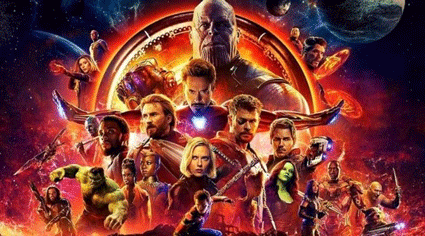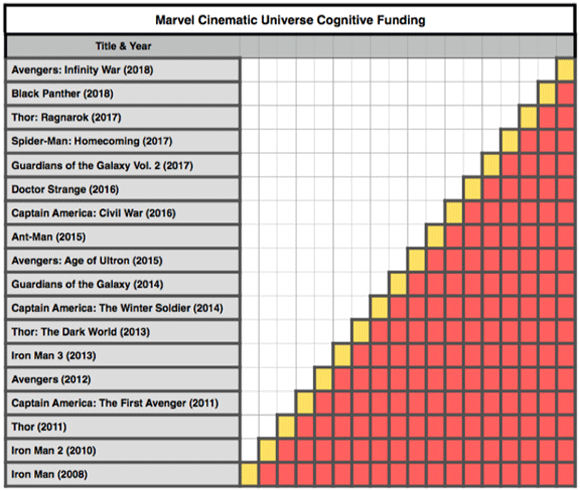In this week’s column, Center chief strategy officer Brad Berens explores why it’s hard to talk about the new Marvel movie out of context.
_______________________________________________________________________________________
By Brad Berens
Although at first this column will seem like a movie review, what I’m really after is a sense of what makes experiences special because we often mistake one part of an experience for the whole: we over-focus on the new thing, the concrete feature, and in doing so we miss the total shape of an experience.
 The new blockbuster movie Avengers: Infinity War is a useful example of what I’m talking about; at the end, I’ll explore how this line of thinking isn’t limited to movies.
The new blockbuster movie Avengers: Infinity War is a useful example of what I’m talking about; at the end, I’ll explore how this line of thinking isn’t limited to movies.
After seeing Infinity War together last weekend, my 12 year-old son asked, “Dad, have we seen Captain America #1 all the way through together?” We deduced that we had not: I tried to show it to him a few years back when his superhero interest was surging, but he was understandably unnerved by the Nazis, and so we stopped mid-flick. He watched it with his friends last summer.
For all its casualness, my son’s question gets to the heart of what makes seeing movies like Infinity War special: a combination of serial experiences and social ones.
Serial experiences and cognitive funding
(Warning: one tiny spoiler ahead.)
Infinity War is the 18th movie in the Marvel Cinematic Universe (MCU)* that started with the first Iron Man exactly 10 years ago on May 2, 2008. Infinity War is remarkable in that it brings in almost all of the major characters from the 17 previous movies. As many reviews have noted, Infinity War is both a terrific popcorn movie experience and an astounding feat of narrative logistics, jumping from group to group at a high velocity and with adept attention to telling a cohesive single story.
What the logistics point misses, though, is that with Infinity War we’re not watching one movie: we’re watching 18. It’s the latest in a series of cumulative experiences in which each new movie builds on the previous one and creates a cognitive fund.** We’re watching the fund. Trying to talk about Infinity War by itself is an exercise in over-focusing.
Here’s how it works graphically:

Each yellow box denotes a new experience, while the orange ones show the ever-growing jackpot size of the fund as time goes by: it’s not just 18 movies: it’s 17 different sets of multiple-movie interactions and a total of 171 boxes.
Infinity War is the first MCU movie that will make neither logical nor emotional sense unless you’ve seen at least some of 17 others: a new viewer can get by having seen only Avengers #1, Guardians of the Galaxy #1, Captain America #3, Doctor Strange and Thor: Ragnarok. That new viewer’s experience, however, will not be as rich as the experience of moviegoers who have seen all 18.
What’s impressive and unprecedented about the MCU as a serial experience is its narrative density — the number of movies and the compression of their releases — 18 movies in 10 years.*** By comparison, the Star Wars series released nine movies in 40 years and the Harry Potter series released eight movies in 10 years.
Social experiences and looping
My son was four years old when the first Iron Man movie came out, so he did not start seeing the movies in the theaters with me until the first Avengers movie in 2012. Since then, we’ve seen all but Doctor Strange in theaters together. (I judged that one to be too scary, so we caught it together on Netflix a few months later.)
The movie is a master class in allusions. At one moment (here’s the tiny spoiler), seemingly out of nowhere but in a way that quickly makes sense, the Red Skull, the villain from the first Captain America movie (2011) pops up: my son and I grabbed onto each other in delighted shock.
Even if it isn’t part of a cumulative series, watching movies with another person in real time — or with an entire audience in the theater — allows our minds to synchronize in what Daniel Goleman calls “looping.” In his 2006 book Social Intelligence, Goleman writes:
As people loop together, their brains send and receive an ongoing stream of signals that allow them to create a tacit harmony– and, if the flow goes the right way, amplify their resonance. Looping lets feelings, thoughts, and actions synchronize. We send and receive internal states for better or for worse– whether laughter and tenderness, or tension and rancor.
Social experiences, in other words, are different than individual ones at a neurological level. I can watch a movie late at night slumped on the couch by myself, but if I do so then I’m not looping with anybody else. The only amplification comes from the speakers on the television.
_________________________________________________________________________________________________
What the logistics point misses, though, is that with Infinity War we’re not watching one movie: we’re watching 18. It’s the latest in a series of cumulative experiences in which each new movie builds on the previous one and creates a cognitive fund. We’re watching the fund. Trying to talk about Infinity War by itself is an exercise in over-focusing.
_________________________________________________________________________________________________
With Infinity War, the together part of the experience is critical: the cognitive fund of the cumulative MCU movies intersects with and amplifies the social fund of cumulative MCU experiences that my son and I have had together.
When people talk about Infinity War by itself, they’re talking about the wrong thing.
Moving beyond movies
Cumulative experiences are embedded in a series of exposures and a social context with other people. Big popcorn movies like Infinity War are only one good example of how paying attention to the total context of a experience can illuminate what makes that experience special, and we can see the structure of these special experiences elsewhere.
The latest issue of Fast Company, for example, features an article about Nike and the future of retail. Over the last few years, Nike has invested time and resources in a smartphone app called Snkrs that creates events around the releases of expensive, limited edition sneakers that attract super-customers known as “hypebeasts” who both collect the sneakers and sell them in an extensive secondary market.
The hypebeasts are brand loyalists who have a cognitive fund around Nike sneakers, and the release events bring groups of hypebeasts together in real time in environments where looping can occur. The shape of what makes these experiences special is similar to the shape of Infinity War, although at a smaller size.
As we experience more and more of our lives separately — buying things online instead of in stores, watching things by ourselves on laptops and tablets rather than with others — it’s helpful to remember that what makes a product special often has more to do with how it is embedded in our lives than with any single feature of the product itself.
__________
*Attentive fans of these movies might argue that the proper number here is 19 rather than 18, since some students of these things — including Marvel Studios itself — argue that 2008’s The Incredible Hulk should be included in the MCU. However, the point I’m trying to make in this column is not about what the studio labels the films but about how moviegoers experience them. The first Iron Man movie (2008) came out of Paramount and in the now-requisite end of credits sequence explicitly called out that a movie about The Avengers was coming in the not-so-distant future. That sequence signaled to the audience that Iron Man was the first of a series of movies. In contrast, The Incredible Hulk was released by Universal and had no such signal. In this, The Incredible Hulk was like the Fantastic Four and X-Men movies released by Fox that had no connectivity to the movies coming out of Paramount or the similar Spider-Man movies coming out of Sony– they all shared common source material from Marvel comic books but didn’t otherwise connect. By 2016 with Spider-Man: Homecoming, Disney had purchased Marvel and begun to integrate all the characters under one cinematic roof, brokering an agreement with Sony that Spider-Man would join the MCU. In late 2017, Disney began a process to acquire Fox that would integrate still more of the characters from Marvel comic books into the MCU.
**I’m adapting “cognitive funding” from U.C. Berkeley philosophy and aesthetics professor Stephen Coburn Pepper’s “aesthetic funding.” In his 1945 book, The Basis of Criticism in the Arts, Pepper defined a work of art as, “a cumulative succession of intermittent perceptions. It is P1 + P2 + P3 +…. The aesthetic work of art is not continuous but intermittent” (page 71). In other words, when we’re looking at Da Vinci’s Mona Lisa we’re not just looking at it in the moment: we’re also building on all of our previous moments of viewing. Pepper called this “funding,” where “a late perception in a series thus carries to considerable degree the results of previous perceptions as it constituents” (page 148). The difference between what Pepper discussed and what I’m talking about is that Pepper is analyzing a single work of art over time, whereas I’m talking about a series of related narrative experiences, each one layered on top of the previous ones. With MCU movies, for many people the experience is ever more complicated since: they might have watched some or all of the movies multiple times; there are other Marvel movies outside of the MCU that will be in the minds of fans, and there are also nearly 80 years worth of comic books dating back to the first appearance of Captain America in 1941 that will be in the minds of the most experienced fans.
***There are also several different television shows that exist in the MCU, including Marvel’s Agents of S.H.I.E.L.D on ABC and an interlocking cluster of shows on Netflix.

Brad Berens is the Center’s Chief Strategy Officer.
See all columns from the Center.
May 2, 2018

